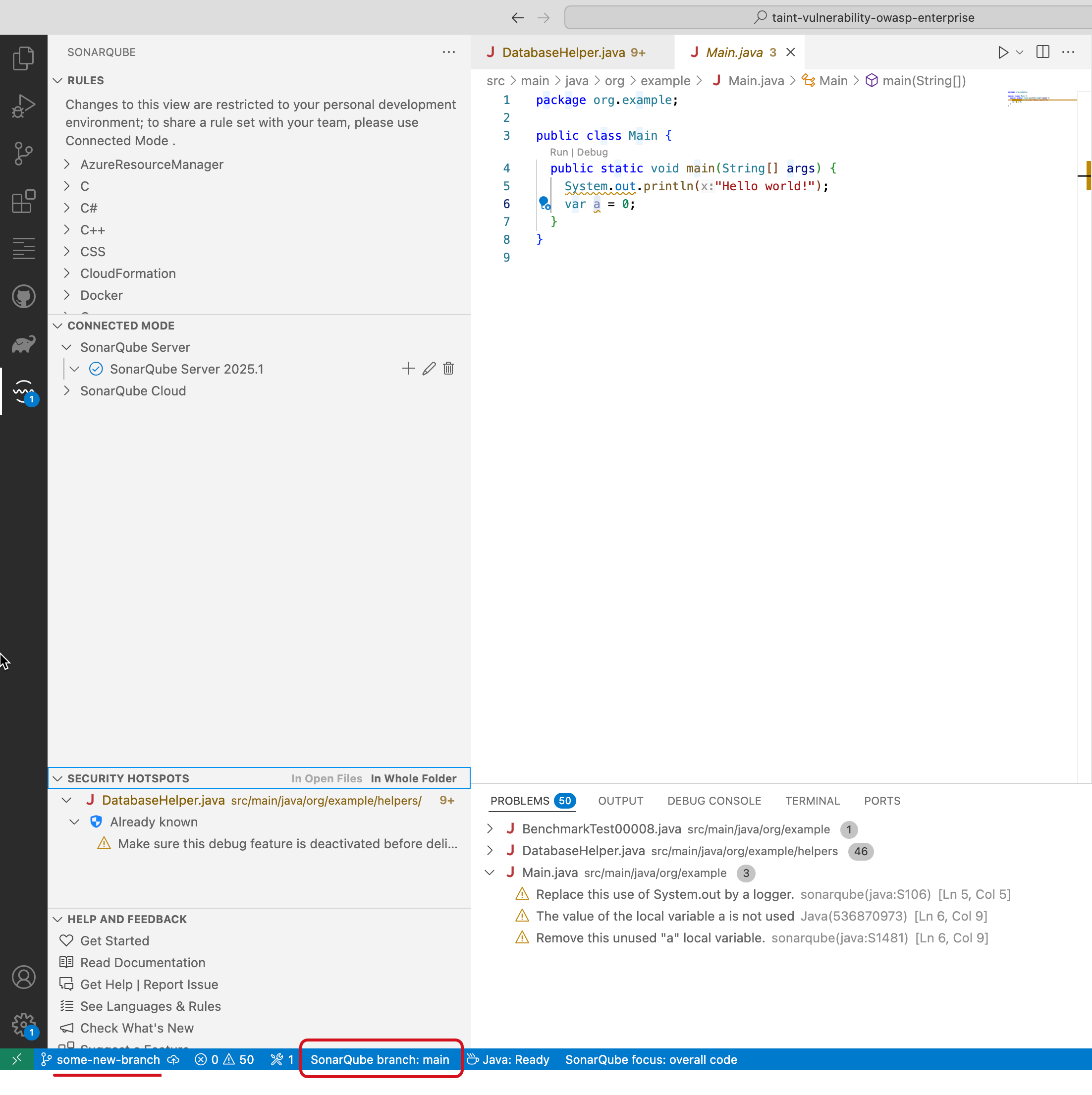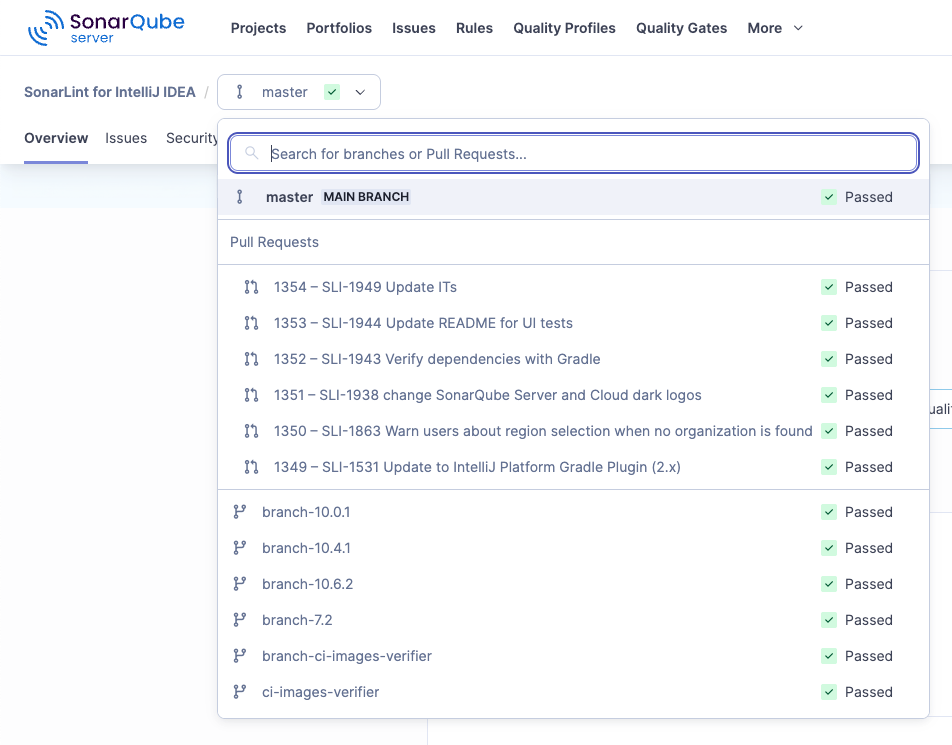Connected mode
Connecting SonarQube for IDE to SonarQube Server, SonarQube Cloud, or SonarQube Community Build is the first step in setting up the Sonar Solution, to take advantage of having consistent issues reported on both sides. Setting up connected mode will permit the transmission of information SonarQube for IDE needs, such as URLs and user credentials or file exclusions and marked issues, to communicate with SonarQube (Server, Cloud) or SonarQube Community Build. When binding your local workspace folder to your SonarQube (Server, Cloud) or SonarQube Community Build project(s), SonarQube for IDE will try to match, as much as possible, the same rules and settings as found on the server.
While in connected mode, SonarQube for IDE receives notifications from SonarQube (Server, Cloud) or SonarQube Community Build about your quality gate changes and new issues. Smart notifications can be enabled or disabled from the UI while creating or editing the connection settings.
Benefits
- Analyze more languages and detect more issues by combining SonarQube for IDE’s supported rules with those supported by SonarQube Server, SonarQube Cloud, and SonarQube Community Build.
- Highlight advanced issues (in the IDE) like injection vulnerabilities, detected by SonarQube Server and SonarQube Cloud.
- An issue discovered in SonarQube (Server, Cloud) or SonarQube Community Build can be quickly opened in the IDE via a dedicated button.
- Use the same quality profile locally as is defined on the SonarQube Server, SonarQube Cloud or SonarQube Community Build server. You'll also see rules in the same rule mode as defined in SonarQube Server or SonarQube Community Build.
- Apply settings, such as rule selection and file exclusions defined on the SonarQube Server, SonarQube Cloud, or SonarQube Community Build server to your local analysis.
- Define specific analyzer parameters in SonarQube Server, SonarQube Cloud, or SonarQube Community Build and have those parameters applied locally.
- Changes in your SonarQube Server, SonarQube Cloud, or SonarQube Community Build quality gate will arrive in your IDE when you accept Smart notifications.
- Automatically suppress issues that are marked as Accepted or False Positive in SonarQube Server, on SonarQube Cloud, or in SonarQube Community Build so that locally reported issues match those found on the server.
When running in connected mode with SonarQube Server 10.4 or newer, Won’t Fix becomes Accept.
Connected mode does not push issues to the server. Rather, its purpose is to configure the IDE so that it uses the same settings, as much as possible, as it is defined on the server.
Free and open-source versions of SonarQube Server and SonarQube Cloud are available to work in connected mode. In SonarQube Cloud, it’s always free to analyze your publicly accessible projects; subscription plans are required only if linking to a private repository.
Prerequisites and supported languages
Having a SonarQube Server project (in an Active version), a SonarQube Cloud project, or a SonarQube Community Build project is required to run SonarQube for VS Code in connected mode. In addition to the published languages on the Rules and languages page, you can unlock Apex rules, COBOL rules, PL/SQL rules, and T-SQL rules when using connected mode with SonarQube Server and SonarQube Cloud.
Branch awareness
Branch awareness allows SonarQube for IDE to consider the branch currently checked out in the IDE and synchronize it with the most appropriate branch from the SonarQube (Server, Cloud) or SonarQube Community Build; we call this branch matching.
In Connected Mode, SonarQube for IDE synchronizes some data from the issues found on the server, such as the issue's status and resolution. It is important that SonarQube for IDE knows which branch the user is on at that moment to sync the local analysis with the correct branch analyzed by SonarQube (Server, Cloud) or SonarQube Community Build.
The use of Git is required for SonarQube for VS Code to find the best match between the local branch and the branch analyzed by SonarQube (Server, Cloud) or SonarQube Community Build.
SonarQube for VS Code shows the name of the branch used to reference issues synchronized in the IDE's status bar. In the picture below, the checked-out git branch is named "current_branch", and the analyzed branch on the SonarQube Server is named "branch_to_analyze".

Checking which branches are analyzed on the server
In SonarQube Server, open the highlighted drop-down list shown below (as it looks in SonarQube Server) for a list of analyzed branches and pull requests.

To analyze branches other than master|main , please check the SonarQube Server or SonarQube Cloud documentation about branch analysis.
How SonarQube for IDE selects which branch to sync
SonarQube for IDE deploys these three methods to choose which branch (in SonarQube (Server, Cloud)) to sync with the local analysis.
Exact match
Branches with the same name are considered the same branch. If the branch that is currently checked out locally is analyzed on the server, SonarQube for IDE will pick this branch for synchronization.
Closest branch
SonarQube for IDE will consider all local branches that also exist on the server. For each branch, SonarQube for IDE will compute the distance between the current HEAD and the branch by the count of commits. The closest branch will be kept. In case the number of commits is the same for two or more branches and the main branch is among them, it will be preferred; otherwise, the tie will be broken with a random choice (from the list of equidistance branches).
Default to main branch
All other cases will default to the branch marked as "main" on the server. For example, if there is an error in reading the branch, or if there is no Git repo, SonarQube for IDE will default to the main branch.
Long and short-lived branches
When using Connected Mode with SonarQube Cloud, issues on short-lived branches are not synchronized. When an issue is marked in SonarQube Cloud accepted or false positive on a short-lived branch, SonarQube for IDE will still show that issue in the IDE.
SonarQube Server does not distinguish between long- and short-lived branches therefore, all issue resolutions are recognized.
PR analysis synchronization
Currently, this feature does not support synchronization with pull request analysis.
Connection setup
SonarQube for VS Code provides a connection wizard to help you set up connected mode with SonarQube (Server, Cloud) or SonarQube Community Build. Please see the Connected mode setup page for detailed instructions to set up connected mode and bind your project.
Sharing your setup
It's possible to share a setup configuration file with your team, simplifying the process.
One team member must step through the first-time setup process, and then export and commit the binding configuration to the repository. Any team member running SonarQube for IDE will find the binding details inside the project's source folder and automatically receive a notification to bind the project.
Please see the Connected mode setup page for detailed instructions.
Known limits
Some features do not work when running in connected mode. Here are the reasons why:
Open in IDE
When running SonarQube for IDE in connected mode with SonarQube Server 10.3 and above, SonarQube Cloud, or SonarQube Community Build, the Open in IDE feature is available. This feature relies on local communication between your web browser and SonarQube for VS Code therefore, is not available in some remote environments such as GitPod, or GitHub CodeSpaces.
Jupyter notebooks
When working with Jupyter Notebooks, connected mode will be ignored. You will only have local analysis. This is because SonarQube (Server, Cloud) or SonarQube Community Build does not yet support the analysis of Jupyter Notebooks.
SonarQube for IDE-SonarQube Server version support policy
SonarQube for IDE enables users to establish a connection to the latest SonarQube Server version and to the latest LTA (Long-Term Active) version. When a new LTA version is released, we still enable connecting SonarQube for IDE to the previous LTA version for a certain period of time (currently 9 months after the latest LTA release) to allow enough time for organizations to update their SonarQube Server version.
For more information about long-term support of SonarQube Server, check out our page describing the SonarQube Server release model. Review your SonarQube for IDE-specific requirements for version-to-version differences.
⚠️ The 8.9LTA reached its support expiration date (in November ’23).
Notifications
Connected mode allows SonarQube (Server, Cloud) and SonarQube Community Build to send smart alerts to individuals or teams as soon as something appears on the server that something failed, when new issues are discovered or when the Sonar Quality Profile is updated, for example. With everyone in the loop, issues can be addressed promptly, improving the overall software quality and delivery. The notification will include a link to call back to SonarQube (Server, Cloud) and SonarQube Community Build where you can learn more about the issues that were introduced.
You'll receive smart notifications in your IDE when:
- the quality gate status of a project open in your IDE changes (see the SonarQube Server, SonarQube Cloud, or SonarQube Community Build documentation for details about using quality gates in your project)
- a SonarQube (Server, Cloud) and SonarQube Community Build analysis raises new issues that you've introduced in a project open in your IDE
You can activate or deactivate smart notifications in SonarQube for IDE on the IDE side for a server-by-server basis.
Sonar Smart Notifications are available in all editions of SonarQube (Server, Cloud) and SonarQube Community Build.
Was this page helpful?